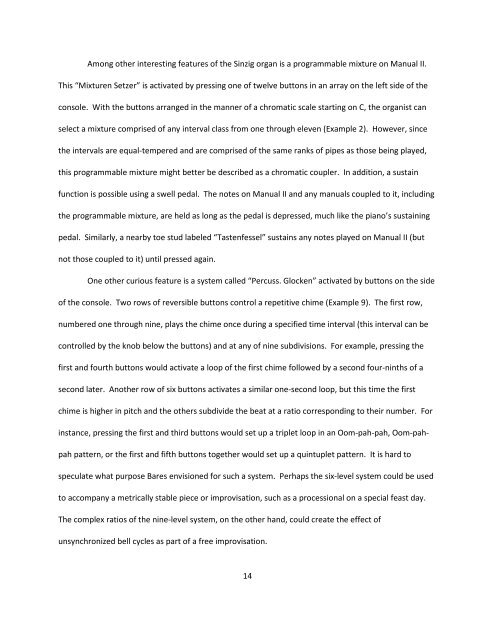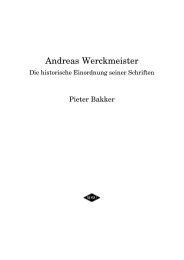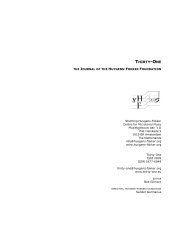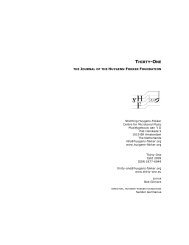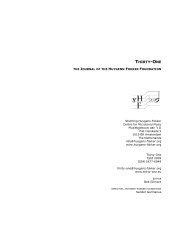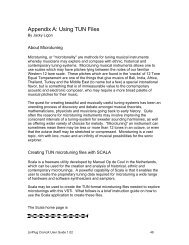Recent Organ Design Innovations and the 21st-century - Stichting ...
Recent Organ Design Innovations and the 21st-century - Stichting ...
Recent Organ Design Innovations and the 21st-century - Stichting ...
Create successful ePaper yourself
Turn your PDF publications into a flip-book with our unique Google optimized e-Paper software.
Among o<strong>the</strong>r interesting features of <strong>the</strong> Sinzig organ is a programmable mixture on Manual II.<br />
This “Mixturen Setzer” is activated by pressing one of twelve buttons in an array on <strong>the</strong> left side of <strong>the</strong><br />
console. With <strong>the</strong> buttons arranged in <strong>the</strong> manner of a chromatic scale starting on C, <strong>the</strong> organist can<br />
select a mixture comprised of any interval class from one through eleven (Example 2). However, since<br />
<strong>the</strong> intervals are equal-tempered <strong>and</strong> are comprised of <strong>the</strong> same ranks of pipes as those being played,<br />
this programmable mixture might better be described as a chromatic coupler. In addition, a sustain<br />
function is possible using a swell pedal. The notes on Manual II <strong>and</strong> any manuals coupled to it, including<br />
<strong>the</strong> programmable mixture, are held as long as <strong>the</strong> pedal is depressed, much like <strong>the</strong> piano’s sustaining<br />
pedal. Similarly, a nearby toe stud labeled “Tastenfessel” sustains any notes played on Manual II (but<br />
not those coupled to it) until pressed again.<br />
One o<strong>the</strong>r curious feature is a system called “Percuss. Glocken” activated by buttons on <strong>the</strong> side<br />
of <strong>the</strong> console. Two rows of reversible buttons control a repetitive chime (Example 9). The first row,<br />
numbered one through nine, plays <strong>the</strong> chime once during a specified time interval (this interval can be<br />
controlled by <strong>the</strong> knob below <strong>the</strong> buttons) <strong>and</strong> at any of nine subdivisions. For example, pressing <strong>the</strong><br />
first <strong>and</strong> fourth buttons would activate a loop of <strong>the</strong> first chime followed by a second four-ninths of a<br />
second later. Ano<strong>the</strong>r row of six buttons activates a similar one-second loop, but this time <strong>the</strong> first<br />
chime is higher in pitch <strong>and</strong> <strong>the</strong> o<strong>the</strong>rs subdivide <strong>the</strong> beat at a ratio corresponding to <strong>the</strong>ir number. For<br />
instance, pressing <strong>the</strong> first <strong>and</strong> third buttons would set up a triplet loop in an Oom-pah-pah, Oom-pah-<br />
pah pattern, or <strong>the</strong> first <strong>and</strong> fifth buttons toge<strong>the</strong>r would set up a quintuplet pattern. It is hard to<br />
speculate what purpose Bares envisioned for such a system. Perhaps <strong>the</strong> six-level system could be used<br />
to accompany a metrically stable piece or improvisation, such as a processional on a special feast day.<br />
The complex ratios of <strong>the</strong> nine-level system, on <strong>the</strong> o<strong>the</strong>r h<strong>and</strong>, could create <strong>the</strong> effect of<br />
unsynchronized bell cycles as part of a free improvisation.<br />
14


